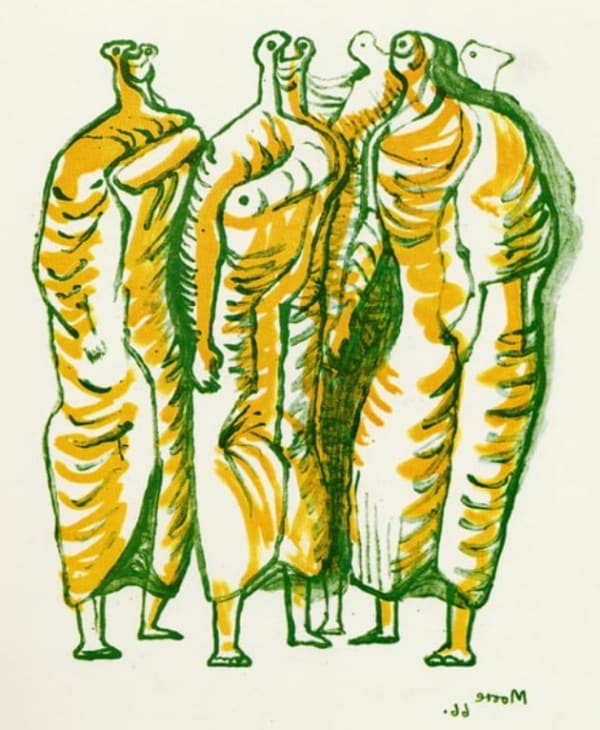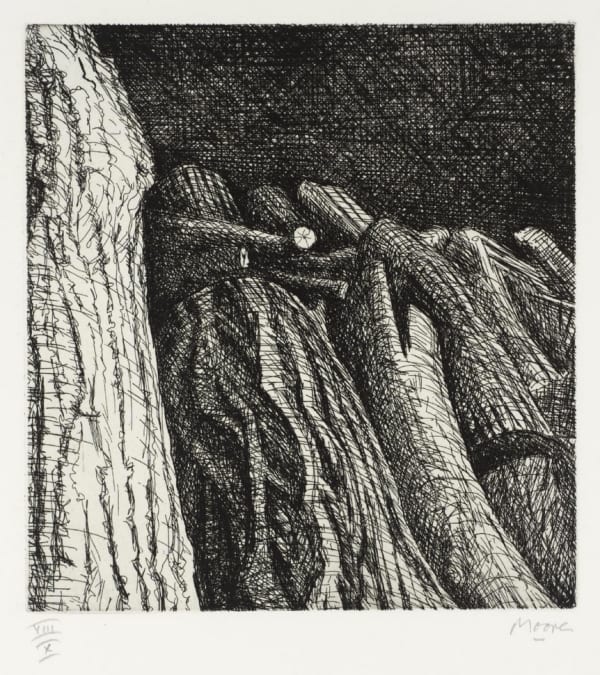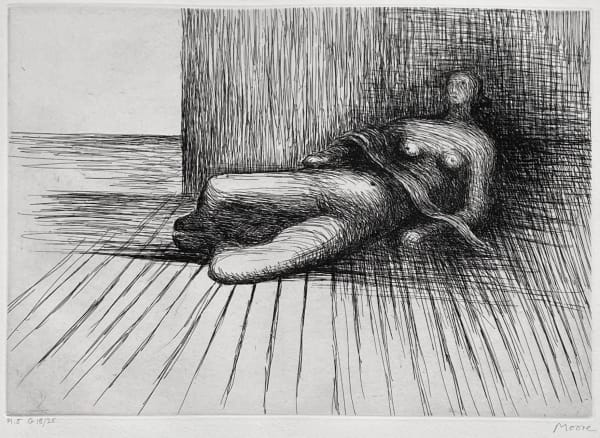Henry Moore 1898-1986
Henry Moore is one of the most significant British artists of the twentieth century. He was born on 30 July 1898 in Castleford, Yorkshire, the son of a miner and the seventh of eight children. He was injured in World War One, as a soldier, in 1917 by a gas attack during the Battle of Cambrai. In 1919, thanks to an ex-serviceman's grant, Moore became a student at the Leeds School of Art. He went on to attend the Royal College of Art in London in 1921. Moore later taught at the College and met Irina Radetsky, whom he married in 1929.
Numerous commissions and exhibitions in the 1930s enabled Moore's reputation as a leading avant-garde artist to grow, but in 1939 war broke out again. Moore was recruited as an official war artist and produced his now famous drawings of people sheltering in the London Underground during the Blitz.
Landscape was important to Moore and his work is often associated with nature. The human body is another recurring motif in the artist's work and in Perry Green the analogies between the body and landscape could be readily explored.
International success characterised Moore's career from the 1950s onward. In 1977 he established the Henry Moore Foundation to encourage wider enjoyment and opportunities in the arts.
In August 1986 Henry Moore died in Perry Green.
-
 Henry MooreReclining Figure, 1978etching19 x 25cm (plate)
Henry MooreReclining Figure, 1978etching19 x 25cm (plate)
24.6 x 35.6cm (sheet)unsigned -
 Henry MooreReclining Nude, 1977-78etching and wash14.5 x 20.1cm (plate) 23 x 30.2cm (paper)rare trial proofunsigned
Henry MooreReclining Nude, 1977-78etching and wash14.5 x 20.1cm (plate) 23 x 30.2cm (paper)rare trial proofunsigned -
 Henry MooreReclining Nude, 1977-78etching14.5 x 20.1cm (plate) 23 x 30.2cm (paper)rare trial proofunsigned
Henry MooreReclining Nude, 1977-78etching14.5 x 20.1cm (plate) 23 x 30.2cm (paper)rare trial proofunsigned -
 Henry MooreSeated Figure and Ideas for Sculpture, 1973-4lithograph26.7 x 24.4cmsigned
Henry MooreSeated Figure and Ideas for Sculpture, 1973-4lithograph26.7 x 24.4cmsigned -
 Henry MooreStonehenge III, Against the Sky, 1973lithogragh, edition: Artist's Proof
Henry MooreStonehenge III, Against the Sky, 1973lithogragh, edition: Artist's Proof
signed
Public Collections: Henry Moore Foundation; Tate Galleries; Met Museum, New YorkImage: 32 x 45.4cm
Paper: 45.8 x 58cm -
 Henry MooreStonehenge IX, Head of a Giant, 1973lithograph41.2 x 29cm (plate) 57.7 x 46cm (paper)edition 23 of 60signed
Henry MooreStonehenge IX, Head of a Giant, 1973lithograph41.2 x 29cm (plate) 57.7 x 46cm (paper)edition 23 of 60signed -
 Henry MooreStonehenge V, Hacked Stone, 1973lithograph29.3 x 45.5cm (plate) 57.7 x 46cm (paper)edition 23 of 60signed
Henry MooreStonehenge V, Hacked Stone, 1973lithograph29.3 x 45.5cm (plate) 57.7 x 46cm (paper)edition 23 of 60signed -
 Henry MooreStonehenge V, Hacked Stone, 1973lithograph29.3 x 45.5cm (plate) 57.7 x 46cm (paper)edition 23 of 60signed
Henry MooreStonehenge V, Hacked Stone, 1973lithograph29.3 x 45.5cm (plate) 57.7 x 46cm (paper)edition 23 of 60signed -
 Henry MooreStonehenge V, Hacked Stone, 1973lithograph, edition of 25
Henry MooreStonehenge V, Hacked Stone, 1973lithograph, edition of 25
signed
Public Collections: The Met Museum, New York; Tate Galleries; Henry Moore Foundation29.3 x 45.5cm (plate) 57.7 x 46cm (paper)edition 23 of 60 -
 Henry MooreStonehenge XI, 1973lithograph
Henry MooreStonehenge XI, 1973lithograph
edition of 6045 x 28.5cmsigned -
 Henry MooreThree Reclining Figures, 1971lithograph on paper19.9 x 19.2cmedition of 5000unsigned
Henry MooreThree Reclining Figures, 1971lithograph on paper19.9 x 19.2cmedition of 5000unsigned -
 Henry MooreStanding Figures 66, 1966lithograph23.5 x 20.3cmsigned in the plate
Henry MooreStanding Figures 66, 1966lithograph23.5 x 20.3cmsigned in the plate -
 Henry MooreTwo Upright Motives, 1966lithograph16.6 x 14.1cm 38 x 30.8cmedition 53 of 65signed
Henry MooreTwo Upright Motives, 1966lithograph16.6 x 14.1cm 38 x 30.8cmedition 53 of 65signed -
 Henry MooreLog Pile Ietching and drypoint19.9 x 19.2cm (plate) 42.2 x 36.2cm (paper)edition 9 of 50signed
Henry MooreLog Pile Ietching and drypoint19.9 x 19.2cm (plate) 42.2 x 36.2cm (paper)edition 9 of 50signed -
 Henry MooreLog Pile Ietching and drypoint
Henry MooreLog Pile Ietching and drypoint
edition of 50
signed
Public Collections: Henry Moore Foundation; Tate Galleries19.9 x 19.2cm (plate) 42.2 x 36.2cm (paper)edition 9 of 50signed -
 Henry MooreReclining Figure 5etching, edition 6 of 7522.9 x 30.5cm (plate)
Henry MooreReclining Figure 5etching, edition 6 of 7522.9 x 30.5cm (plate)
44.5 x 51.5cm (paper)signed -
 Henry MooreStonehenge II, Sarsens and Lintellithograph28.8 x 45.3cm (plate) 45.8 x 58cm (paper)edition 23 of 60signed
Henry MooreStonehenge II, Sarsens and Lintellithograph28.8 x 45.3cm (plate) 45.8 x 58cm (paper)edition 23 of 60signed
-

MODERN MASTERS
Henry Moore | Ben Nicholson | Peter Blake | George Dannatt | Raoul Dufy 5 - 30 Aug 2022Read more -

Impressions on Paper
4 Feb - 1 Mar 2022This is the gallery's eighth annual exhibition dedicated entirely to works of art on paper through painting, etching, engraving, woodcut and linocut prints. In anticipation of a major exhibition of...Read more




















